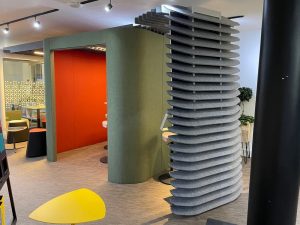The COVID-19 pandemic has changed the way we work. The lockdown-mandated flip to homeworking had a profound impact, not only on how and where we work, but also on work culture, office space design and work-life balance.
So, three years out, what have we learned and what will we take forward? How have our expectations and priorities shifted, and what may the future of the physical office look like?
 Home and Hybrid Working
Home and Hybrid Working
The rise of homeworking is clearly one of the most fundamental changes we’ve seen in our workplaces, bringing benefits to staff (who appreciate the better work-life balance, and reduced commuting time) and to employers (who may have been able to jettison some of their office space and overheads).
However, homeworking also presents challenges, such as the potential for decreased social interaction and collaboration, and blurred boundaries between work and life, making it harder for people to switch off.
Recently, a more nuanced understanding of the challenges and benefits of this way of working is emerging as initial impressions are questioned, including the idea that working from home is more productive for all. For example, does personal productivity always tally with organisational goals? A morning spent clearing an Inbox, for example, might prompt a great sense of personal achievement, but has that time advanced the aims and success of the business?
The understanding of how hybrid working impacts communication and relationships has also shifted over time. Whilst meetings and one-to-one calls can go ahead virtually, communication with the wider circles of a work network, which is much more dependent on serendipitous meetings and shared physical spaces, is less well served.
That lack of interaction beyond your immediate colleagues and managers can also dampen creativity, leaving people at risk of ‘echo chamber’ effect, where their own thinking is reinforced by their immediate team.
Whilst the widespread success of hybrid working is unquestioned, it is by no means a universal solution, and managing it effectively to accommodate the disparate needs of all employees is complex.

The move to hybrid work has also necessitated a rethink of office spaces. With far fewer people in at any one time, offices are getting smaller and/or being redesigned to better serve their shifted purpose.
The office is no longer a place where workers are “housed” for the 9-5. Instead, the modern office functions more as a magnetic hub, drawing colleagues together, with a focus on relationship building, and creative and collaborative work.
Rather than a desk-based or even a hot-desking model, more companies are adopting activity-based working, where employees can choose where and how they work, based on their tasks and preferences. As such, demand has risen for furniture and office design elements which can help support the four key working behaviours – Collaboration, Communication, Concentration, and Contemplation.
Rather than banks of desks, we’re seeing more break-out and touchdown spaces, improved kitchens and canteens to maximise the opportunities to develop that vital social capital, as well as quiet spaces – silent pods, phone boxes and acoustic booths – alongside social and open plan spaces.
Flexible and configurable furniture which can be reviewed and redeployed is in favour – including mobile pods, which can be used alone for a private workspace, or in combination. Overall, office furniture and office space are having to work harder and smarter than ever before.
A Culture Shift
Covid doubtless reshaped priorities, expectations and norms in the workplace. The widespread isolation and stresses of lockdown brought mental health to the fore across society. That heightened awareness catalysed a renewed focus on employee wellbeing and mental health support. It also demanded a more comprehensive understanding of neurodiversity, ADHD, menopause and other, previously ignored, considerations when optimising employee wellbeing.
Companies have responded to this need by prioritising employee wellbeing and creating holistic programs to support mental and physical health. For instance, mental health days, flexible schedules, and access to virtual counselling services have been added to existing ergonomics programmes, wellbeing-boosting movement and activities during the working day.
Finally, the pandemic has redefined expectations and norms around work-life balance. Freed from a 9-5 working day followed by a commute, employees now have the flexibility to incorporate personal and family activities around their work commitments.
Such a permeable boundary between ‘work’ and ‘life’ comes with its own challenges, but employers are getting better at managing them, for example with policies around work hours, out of hours emails, flexible schedules, meeting-free days and respecting time off. This new way of working also demands robust boundary setting by employees, who have far more responsibility for managing their own time effectively.
In summary, it’s abundantly clear that the pandemic has significantly and permanently changed the way we work. To thrive in this new era, we must prioritise employee wellbeing and mental health support, rethink office spaces to support key working behaviours, whilst boosting corporate culture, and creating policies and practices that support work-life balance.
Get it right, and this brave new world of work can deliver significant benefits to all.
